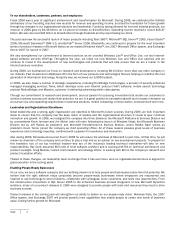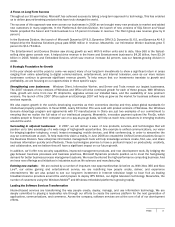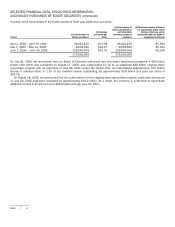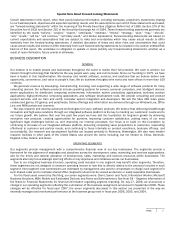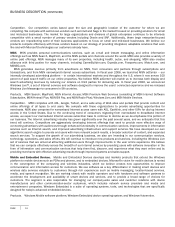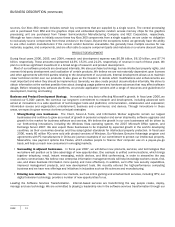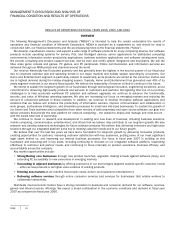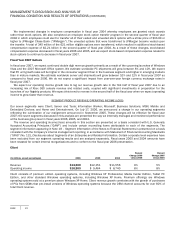Microsoft 2006 Annual Report Download - page 13
Download and view the complete annual report
Please find page 13 of the 2006 Microsoft annual report below. You can navigate through the pages in the report by either clicking on the pages listed below, or by using the keyword search tool below to find specific information within the annual report.
PAGE 12
BUSINESS DESCRIPTION (CONTINUED)
sources. Our Xbox 360 console includes certain key components that are supplied by a single source. The central processing
unit is purchased from IBM and the graphics chips and embedded dynamic random access memory chips for the graphics
processing unit are purchased from Taiwan Semiconductor Manufacturing Company and NEC Corporation, respectively.
Although we have chosen to initially source these key Xbox 360 components from a single supplier, we are under no obligation
to exclusively source components from these vendors in the future. Beyond the exceptions noted, we generally have the ability
to use other custom manufacturers if the current vendor becomes unavailable. We generally have multiple sources for raw
materials, supplies, and components, and are often able to acquire component parts and materials on a volume discount basis.
PRODUCT DEVELOPMENT
During fiscal years 2006, 2005, and 2004, research and development expense was $6.58 billion, $6.10 billion, and $7.74
billion, respectively. Those amounts represented 14.9%, 15.3%, and 21.0%, respectively, of revenue in each of those years. We
plan to continue significant investment in a broad range of research and product development.
Most of our software products are developed internally. We also purchase technology, license intellectual property rights, and
oversee third-party development and localization of certain products. We believe we are not materially dependent upon licenses
and other agreements with third parties relating to the development of our products. Internal development allows us to maintain
closer technical control over our products. It also gives us the freedom to decide which modifications and enhancements are
most important and when they should be implemented. Generally, we also create product documentation internally. We strive to
obtain information at the earliest possible time about changing usage patterns and hardware advances that may affect software
design. Before releasing new software platforms, we provide application vendors with a range of resources and guidelines for
development, training, and testing.
Business and Product Development Strategy. Innovation is a key factor affecting Microsoft’s growth. In fiscal year 2006, we
received our 5,000th patent. We continue our long-term commitment to research and development, including advanced work
aimed at innovations in a wide spectrum of technologies: tools and platforms; communication, collaboration and expression;
information access and organization; entertainment; business and e-commerce; and devices. Through innovations in these
areas, we expect to grow revenue via three principal strategies:
• Strengthening core businesses. The Client, Server & Tools, and Information Worker segments remain our largest
businesses and continue to grow as a result of growth in personal computer and server shipments, software upgrades and
growth in the market for business software and services. We believe the growth in our core businesses will be driven by
our forthcoming innovations, including the Windows Vista operating system, the 2007 Microsoft Office system, and
Exchange Server 2007. We also expect these businesses to be impacted by expected growth in the world’s developing
countries, as their economies develop and they adopt global standards for intellectual property protection. In fiscal year
2006, nearly 60 million PCs were sold with pirated versions of Windows. Our Windows Genuine Advantage program and
agreements with PC manufacturers in China are just two examples of our commitment to protect our intellectual property.
Meanwhile, new payment options like FlexGo, which enables people to finance their computer use on a pay-as-you-go
basis, will help us reach new consumers in emerging markets.
• Succeeding in adjacent businesses. In fiscal year 2007, we will deliver new products, services, and technologies that
we believe will position us to take advantage of new opportunities. One example is unified communications, which brings
together telephony, email, instant messaging, mobile devices, and Web conferencing, in order to streamline the way
workers communicate. We believe new enterprise information management tools will help knowledge workers create, find,
use, and share business information more quickly and more effectively. In addition, we’ll offer new security capabilities,
improved management products, and new development tools. We recently entered the high-performance computing
business and we have new offerings and initiatives in industries such as life sciences and manufacturing.
• Entering new markets. We believe new markets, such as online gaming and entertainment services, including IPTV, our
digital television technology, provide a number of new opportunities for us.
Leading the Software Services Transformation. Internet-based services are transforming the way people create, deploy,
manage and use technology. We are committed to playing a leadership role in the software services transformation through our


